
CONSOCIATIONAL DEMOCRACY By AREND LIJPHART* TYPES OF WESTERN DEMOCRATIC SYSTEMS TN Gabriel A.Almond's famous typology of political systems,first expounded in 1956,he distinguishes three types of Western demo- cratic systems:Anglo-American political systems (exemplified by Britain and the United States),Continental European political systems (France,Germany,and Italy),and a third category consisting of the Scandinavian and Low Countries.The third type is not given a distinct label and is not described in detail;Almond merely states that the coun- tries belonging to this type "combine some of the features of the Con- tinental European and the Anglo-American"political systems,and "stand somewhere in between the Continental pattern and the Anglo- American."Almond's threefold typology has been highly influential in the comparative analysis of democratic politics,although,like any provocative and insightful idea,it has also been criticized.This research note will discuss the concept of "consociational democracy"in a con- structive attempt to refine and elaborate Almond's typology of democracies. The typology derives its theoretical significance from the relationship it establishes between political culture and social structure on the one hand and political stability on the other hand.The Anglo-American systems have a "homogeneous,secular political culture"and a"highly differentiated"role structure,in which governmental agencies,parties, interest groups,and the communication media have specialized func- tions and are autonomous,although interdependent.In contrast,the Continental European democracies are characterized by a "fragmenta- tion of political culture"with separate "political sub-cultures."Their roles "are embedded in the sub-cultures and tend to constitute separate sub-systems of roles."2 The terms"Anglo-American"and "Continental European"are used for convenience only and do not imply that geo- This note represents an intermediate stage of a research project concerning political stability in democratic systems.An earlier and briefer discussion of the concept of consociational democracy,in the context of a critical analysis of the utility of typologies in comparative politics,appeared in the author's "Typologies of Democratic Systems," Comparative Political Studies,1 (April 1968),3-44.The author is indebted to the Insti- tute of International Studies,Berkeley,for financial support. 1Gabriel A.Almond,"Comparative Political Systems,"Journal of Politics,xvi (August I956),392-93,405. 2Ibid.,398-99,405-07 (italics omitted)
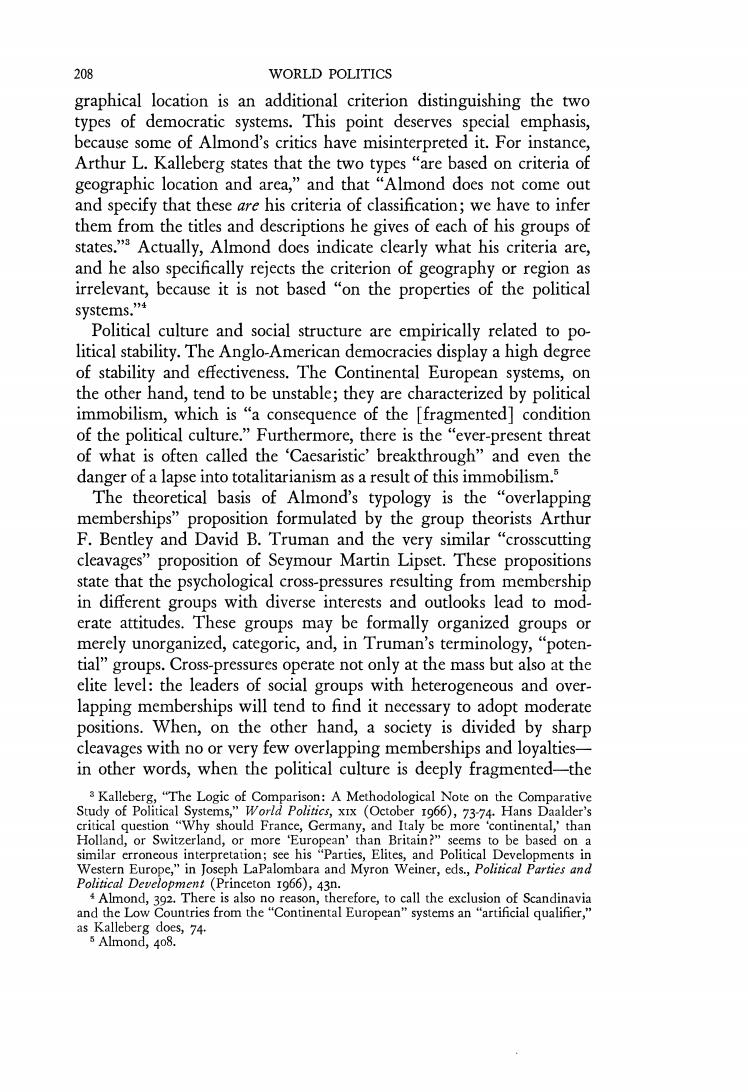
208 WORLD POLITICS graphical location is an additional criterion distinguishing the two types of democratic systems.This point deserves special emphasis, because some of Almond's critics have misinterpreted it.For instance, Arthur L.Kalleberg states that the two types"are based on criteria of geographic location and area,"and that"Almond does not come out and specify that these are his criteria of classification;we have to infer them from the titles and descriptions he gives of each of his groups of states."Actually,Almond does indicate clearly what his criteria are, and he also specifically rejects the criterion of geography or region as irrelevant,because it is not based"on the properties of the political systems."4 Political culture and social structure are empirically related to po- litical stability.The Anglo-American democracies display a high degree of stability and effectiveness.The Continental European systems,on the other hand,tend to be unstable;they are characterized by political immobilism,which is"a consequence of the [fragmented]condition of the political culture."Furthermore,there is the "ever-present threat of what is often called the 'Caesaristic'breakthrough"and even the danger of a lapse into totalitarianism as a result of this immobilism. The theoretical basis of Almond's typology is the "overlapping memberships"proposition formulated by the group theorists Arthur F.Bentley and David B.Truman and the very similar "crosscutting cleavages"proposition of Seymour Martin Lipset.These propositions state that the psychological cross-pressures resulting from membership in different groups with diverse interests and outlooks lead to mod- erate attitudes.These groups may be formally organized groups or merely unorganized,categoric,and,in Truman's terminology,"poten- tial"groups.Cross-pressures operate not only at the mass but also at the elite level:the leaders of social groups with heterogeneous and over- lapping memberships will tend to find it necessary to adopt moderate positions.When,on the other hand,a society is divided by sharp cleavages with no or very few overlapping memberships and loyalties- in other words,when the political culture is deeply fragmented-the 3 Kalleberg,"The Logic of Comparison:A Methodological Note on the Comparative Study of Political Systems,"World Politics,xIx (October 1966),7374.Hans Daalder's critical question "Why should France,Germany,and Italy be more 'continental,'than Holland,or Switzerland,or more 'European'than Britain?"seems to be based on a similar crroncous interpretation;see his "Parties,Elites,and Political Developments in Western Europe,"in Joseph LaPalombara and Myron Weiner,eds.,Political Parties and Political Development (Princeton 1966),43n. +Almond,392.There is also no reason,therefore,to call the exclusion of Scandinavia and the Low Countries from the“Continental European”systems an“artificial qualifier,” as Kalleberg does,74. 5 Almond,408
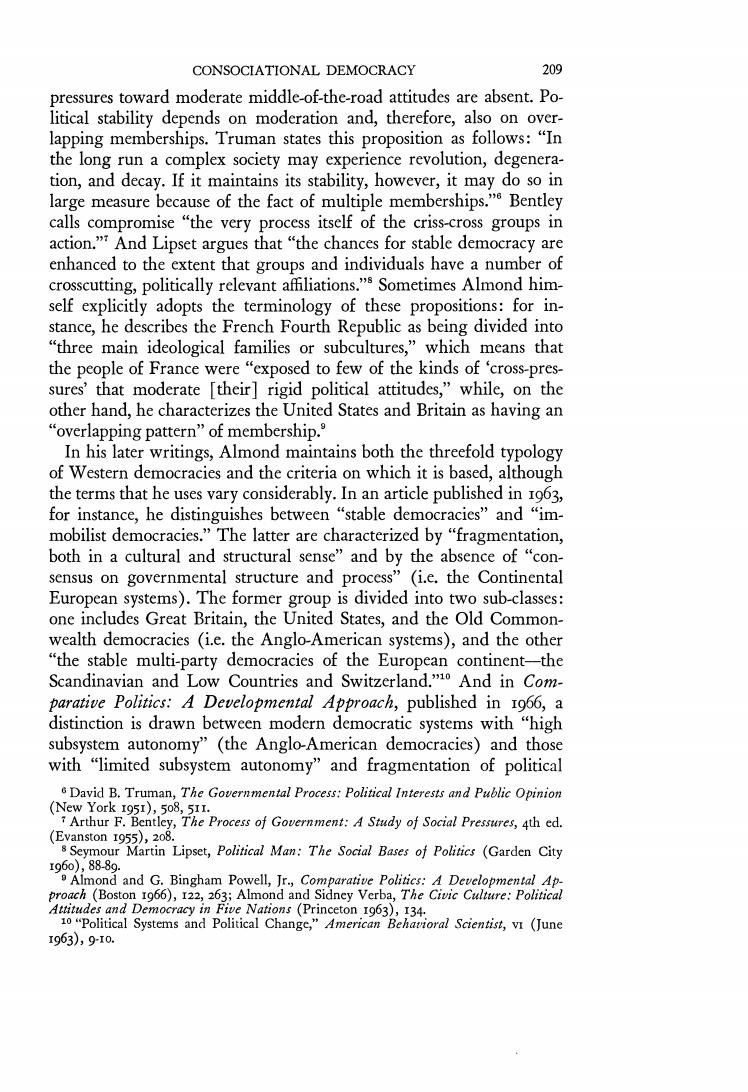
CONSOCIATIONAL DEMOCRACY 209 pressures toward moderate middle-of-the-road attitudes are absent.Po- litical stability depends on moderation and,therefore,also on over- lapping memberships.Truman states this proposition as follows:"In the long run a complex society may experience revolution,degenera- tion,and decay.If it maintains its stability,however,it may do so in large measure because of the fact of multiple memberships."Bentley calls compromise"the very process itself of the criss-cross groups in action.And Lipset argues that"the chances for stable democracy are enhanced to the extent that groups and individuals have a number of crosscutting,politically relevant affiliations.Sometimes Almond him- self explicitly adopts the terminology of these propositions:for in- stance,he describes the French Fourth Republic as being divided into "three main ideological families or subcultures,"which means that the people of France were "exposed to few of the kinds of 'cross-pres- sures'that moderate [their]rigid political attitudes,"while,on the other hand,he characterizes the United States and Britain as having an “overlapping pattern”of membership. In his later writings,Almond maintains both the threefold typology of Western democracies and the criteria on which it is based,although the terms that he uses vary considerably.In an article published in 1963, for instance,he distinguishes between "stable democracies"and "im- mobilist democracies."The latter are characterized by "fragmentation, both in a cultural and structural sense"and by the absence of "con- sensus on governmental structure and process"(i.e.the Continental European systems).The former group is divided into two sub-classes: one includes Great Britain,the United States,and the Old Common- wealth democracies (i.e.the Anglo-American systems),and the other "the stable multi-party democracies of the European continent-the Scandinavian and Low Countries and Switzerland."1 And in Com- parative Politics:A Developmental Approach,published in 1966,a distinction is drawn between modern democratic systems with "high subsystem autonomy"(the Anglo-American democracies)and those with "limited subsystem autonomy"and fragmentation of political David B.Truman,The Governmental Process:Political Interests and Public Opinion (New York I951),508,5II. 1Arthur F.Bentley,The Process of Government:A Study of Social Pressures,4th ed. (Evanston 1955),208. s Seymour Martin Lipset,Political Man:The Social Bases of Politics (Garden City I960),88-89. Almond and G.Bingham Powell,Jr.,Comparative Politics:A Developmental Ap- proach (Boston 1g66),122,263;Almond and Sidney Verba,The Civic Culture:Political Attitudes and Democracy in Five Nations (Princeton 1963),134. 10"Political Systems and Political Change,"American Behavioral Scientist,vI (June I963),9-I0
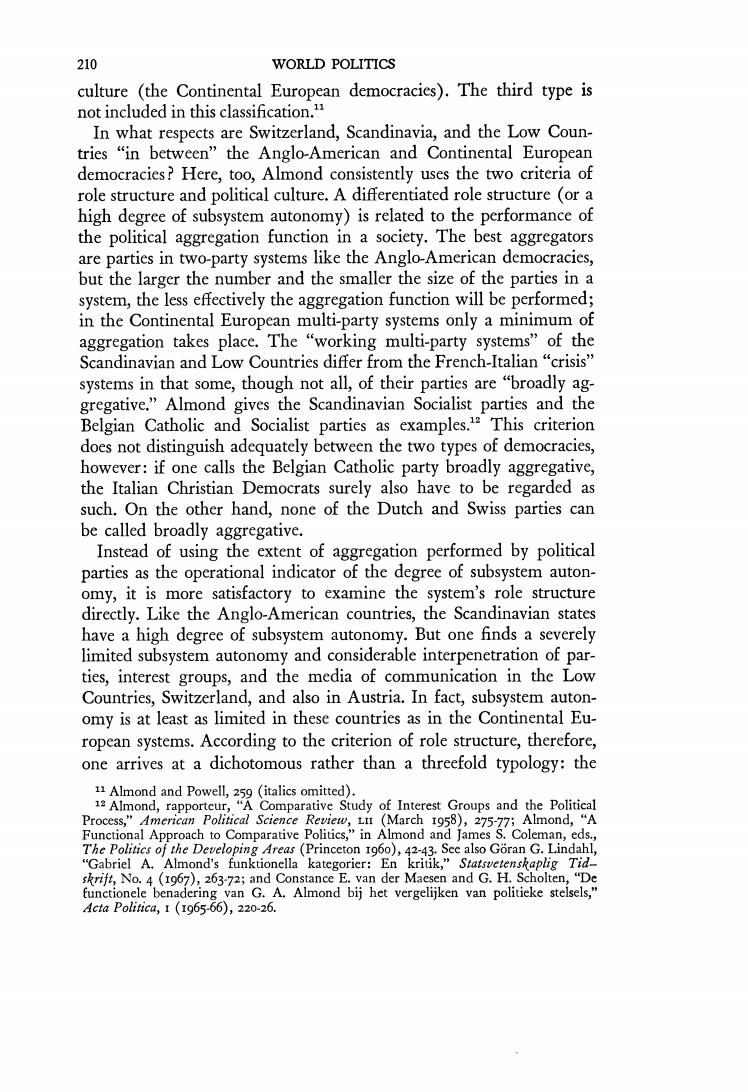
210 WORLD POLITICS culture (the Continental European democracies).The third type is not included in this classification. In what respects are Switzerland,Scandinavia,and the Low Coun- tries "in between"the Anglo-American and Continental European democracies?Here,too,Almond consistently uses the two criteria of role structure and political culture.A differentiated role structure (or a high degree of subsystem autonomy)is related to the performance of the political aggregation function in a society.The best aggregators are parties in two-party systems like the Anglo-American democracies, but the larger the number and the smaller the size of the parties in a system,the less effectively the aggregation function will be performed; in the Continental European multi-party systems only a minimum of aggregation takes place.The "working multi-party systems"of the Scandinavian and Low Countries differ from the French-Italian "crisis" systems in that some,though not all,of their parties are "broadly ag- gregative."Almond gives the Scandinavian Socialist parties and the Belgian Catholic and Socialist parties as examples.This criterion does not distinguish adequately between the two types of democracies, however:if one calls the Belgian Catholic party broadly aggregative, the Italian Christian Democrats surely also have to be regarded as such.On the other hand,none of the Dutch and Swiss parties can be called broadly aggregative. Instead of using the extent of aggregation performed by political parties as the operational indicator of the degree of subsystem auton- omy,it is more satisfactory to examine the system's role structure directly.Like the Anglo-American countries,the Scandinavian states have a high degree of subsystem autonomy.But one finds a severely limited subsystem autonomy and considerable interpenetration of par- ties,interest groups,and the media of communication in the Low Countries,Switzerland,and also in Austria.In fact,subsystem auton- omy is at least as limited in these countries as in the Continental Eu- ropean systems.According to the criterion of role structure,therefore, one arrives at a dichotomous rather than a threefold typology:the 11 Almond and Powell,259 (italics omitted). 1Almond,rapporteur,"A Comparative Study of Interest Groups and the Political Process,"American Political Science Review,Lit (March 1958),275-77;Almond,"A Functional Approach to Comparative Politics,"in Almond and James S.Coleman,eds., The Politics of the Developing Areas (Princeton 1960),42-43.Sec also Goran G.Lindahl, "Gabriel A.Almond's funktionella kategorier:En kritik,"Statsvetenskaplig Tid- skrift,No.4 (1967),263-72;and Constance E.van der Maesen and G.H.Scholten,"De functionele benadering van G.A.Almond bij het vergelijken van politieke stelsels," Acta Politica,1(I965-66),220-26
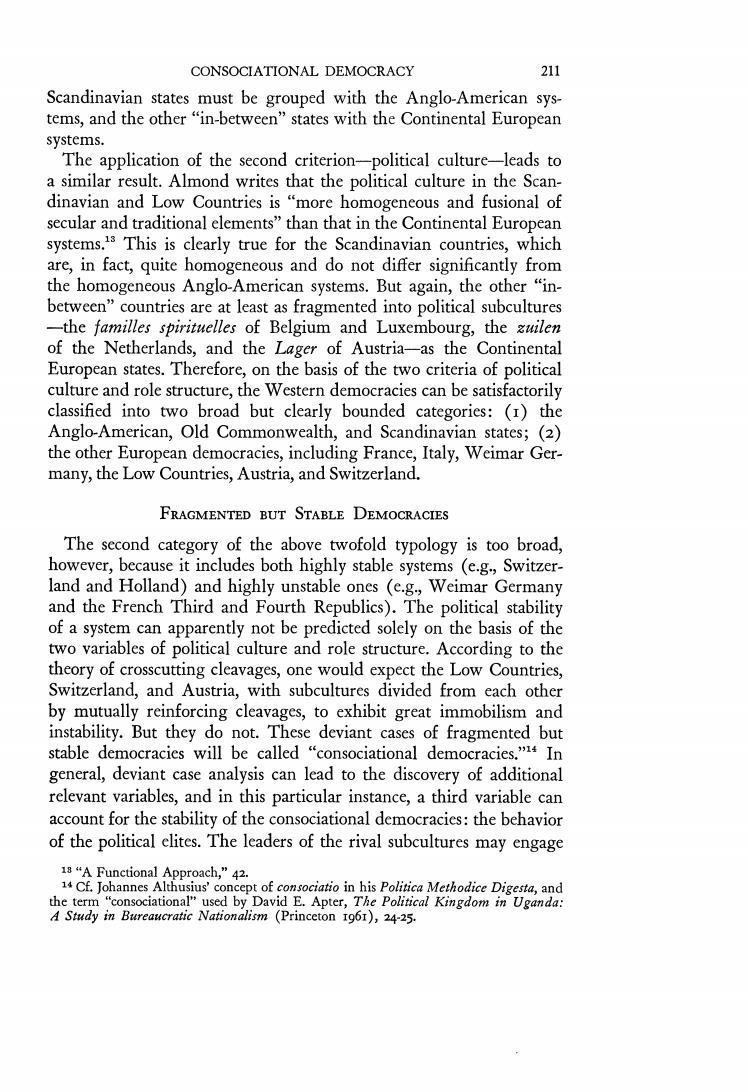
CONSOCIATIONAL DEMOCRACY 211 Scandinavian states must be grouped with the Anglo-American sys- tems,and the other"in-between"states with the Continental European systems. The application of the second criterion-political culture-leads to a similar result.Almond writes that the political culture in the Scan- dinavian and Low Countries is "more homogeneous and fusional of secular and traditional elements"than that in the Continental European systems.This is clearly true for the Scandinavian countries,which are,in fact,quite homogeneous and do not differ significantly from the homogeneous Anglo-American systems.But again,the other "in- between"countries are at least as fragmented into political subcultures -the familles spirituelles of Belgium and Luxembourg,the zuilen of the Netherlands,and the Lager of Austria-as the Continental European states.Therefore,on the basis of the two criteria of political culture and role structure,the Western democracies can be satisfactorily classified into two broad but clearly bounded categories:(I)the Anglo-American,Old Commonwealth,and Scandinavian states;(2) the other European democracies,including France,Italy,Weimar Ger- many,the Low Countries,Austria,and Switzerland. FRAGMENTED BUT STABLE DEMOCRACIES The second category of the above twofold typology is too broad, however,because it includes both highly stable systems (e.g,Switzer- land and Holland)and highly unstable ones (e.g,Weimar Germany and the French Third and Fourth Republics).The political stability of a system can apparently not be predicted solely on the basis of the two variables of political culture and role structure.According to the theory of crosscutting cleavages,one would expect the Low Countries, Switzerland,and Austria,with subcultures divided from each other by mutually reinforcing cleavages,to exhibit great immobilism and instability.But they do not.These deviant cases of fragmented but stable democracies will be called "consociational democracies."In general,deviant case analysis can lead to the discovery of additional relevant variables,and in this particular instance,a third variable can account for the stability of the consociational democracies:the behavior of the political elites.The leaders of the rival subcultures may engage 18“A Functional Approach,”42. 14 Cf.Johannes Althusius'concept of consociatio in his Politica Methodice Digesta,and the term "consociational"used by David E.Apter,The Political Kingdom in Uganda: A Study in Bureaucratic Nationalism (Princeton 1961),24-25
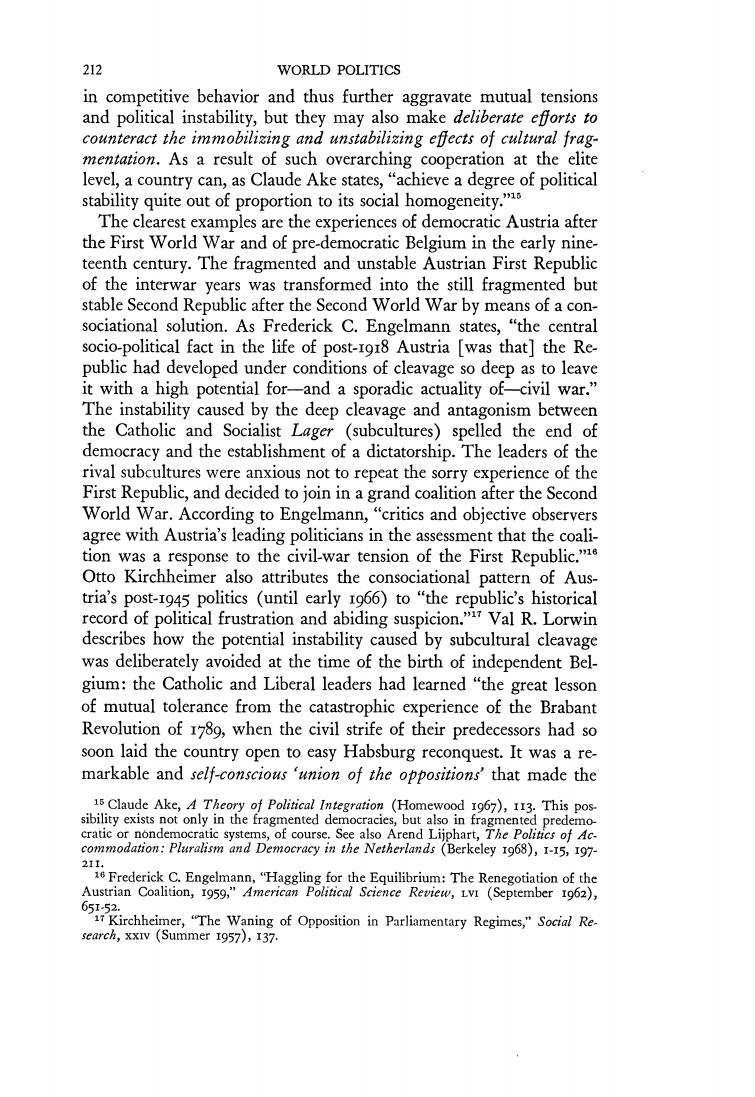
212 WORLD POLITICS in competitive behavior and thus further aggravate mutual tensions and political instability,but they may also make deliberate efforts to counteract the immobilizing and unstabilizing effects of cultural frag- mentation.As a result of such overarching cooperation at the elite level,a country can,as Claude Ake states,"achieve a degree of political stability quite out of proportion to its social homogeneity. The clearest examples are the experiences of democratic Austria after the First World War and of pre-democratic Belgium in the early nine- teenth century.The fragmented and unstable Austrian First Republic of the interwar years was transformed into the still fragmented but stable Second Republic after the Second World War by means of a con- sociational solution.As Frederick C.Engelmann states,"the central socio-political fact in the life of post-1or8 Austria [was that]the Re- public had developed under conditions of cleavage so deep as to leave it with a high potential for-and a sporadic actuality ofcivil war." The instability caused by the deep cleavage and antagonism between the Catholic and Socialist Lager (subcultures)spelled the end of democracy and the establishment of a dictatorship.The leaders of the rival subcultures were anxious not to repeat the sorry experience of the First Republic,and decided to join in a grand coalition after the Second World War.According to Engelmann,"critics and objective observers agree with Austria's leading politicians in the assessment that the coali- tion was a response to the civil-war tension of the First Republic. Otto Kirchheimer also attributes the consociational pattern of Aus- tria's post-1945 politics (until early 166)to"the republic's historical record of political frustration and abiding suspicion.Val R.Lorwin describes how the potential instability caused by subcultural cleavage was deliberately avoided at the time of the birth of independent Bel- gium:the Catholic and Liberal leaders had learned "the great lesson of mutual tolerance from the catastrophic experience of the Brabant Revolution of 1789,when the civil strife of their predecessors had so soon laid the country open to easy Habsburg reconquest.It was a re- markable and self-conscious 'union of the oppositions'that made the 15 Claude Ake,4 Theory of Political Integration (Homewood 1967),113.This pos. sibility exists not only in the fragmented democracies,but also in fragmented predemo- cratic or nondemocratic systems,of course.See also Arend Lijphart,The Politics of Ac- commodation:Pluralism and Democracy in the Netherlands (Berkeley 1968),1-15,197- 2I1, 16 Frederick C.Engelmann,"Haggling for the Equilibrium:The Renegotiation of the Austrian Coalition,1959,"American Political Science Review,LvI (September 1962), 651-52. 11 Kirchheimer,"The Waning of Opposition in Parliamentary Regimes,"Social Re- search,xxiv (Summer 1957),I37
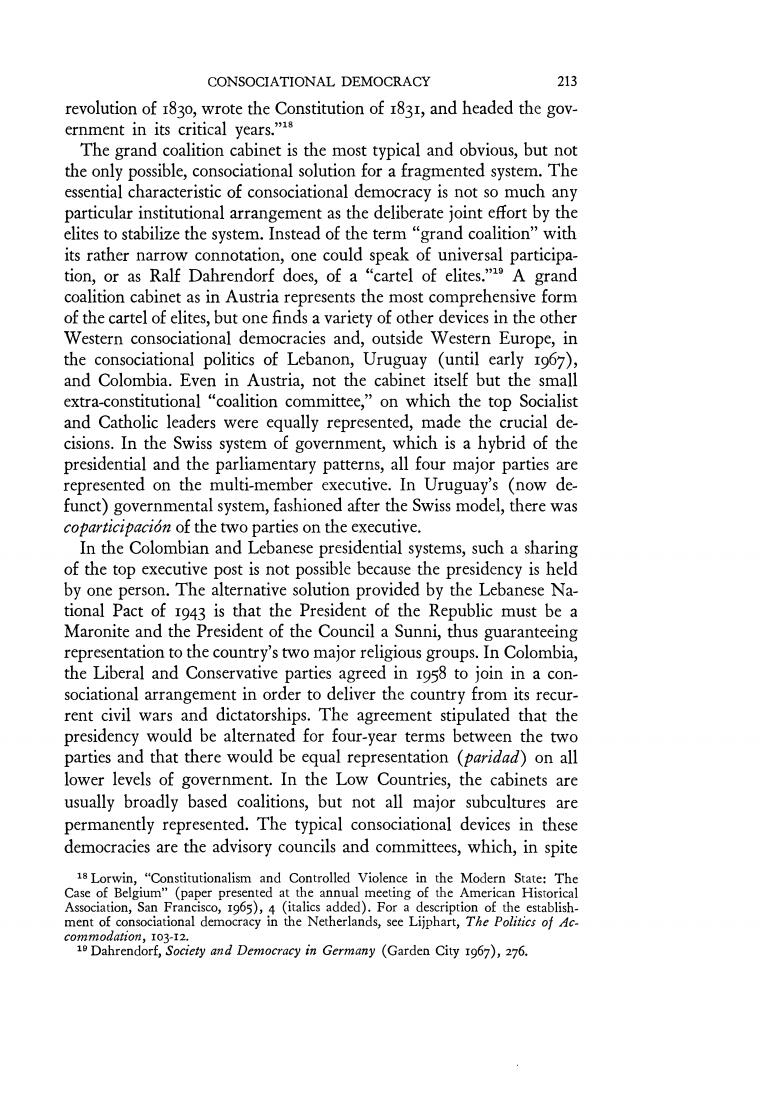
CONSOCIATIONAL DEMOCRACY 213 revolution of 1830,wrote the Constitution of 1831,and headed the gov- ernment in its critical years." The grand coalition cabinet is the most typical and obvious,but not the only possible,consociational solution for a fragmented system.The essential characteristic of consociational democracy is not so much any particular institutional arrangement as the deliberate joint effort by the elites to stabilize the system.Instead of the term"grand coalition"with its rather narrow connotation,one could speak of universal participa- tion,or as Ralf Dahrendorf does,of a "cartel of elites."4A grand coalition cabinet as in Austria represents the most comprehensive form of the cartel of elites,but one finds a variety of other devices in the other Western consociational democracies and,outside Western Europe,in the consociational politics of Lebanon,Uruguay (until early 1967), and Colombia.Even in Austria,not the cabinet itself but the small extra-constitutional "coalition committee,"on which the top Socialist and Catholic leaders were equally represented,made the crucial de- cisions.In the Swiss system of government,which is a hybrid of the presidential and the parliamentary patterns,all four major parties are represented on the multi-member executive.In Uruguay's (now de- funct)governmental system,fashioned after the Swiss model,there was coparticipacion of the two parties on the executive. In the Colombian and Lebanese presidential systems,such a sharing of the top executive post is not possible because the presidency is held by one person.The alternative solution provided by the Lebanese Na- tional Pact of 1943 is that the President of the Republic must be a Maronite and the President of the Council a Sunni,thus guaranteeing representation to the country's two major religious groups.In Colombia, the Liberal and Conservative parties agreed in 1958 to join in a con- sociational arrangement in order to deliver the country from its recur- rent civil wars and dictatorships.The agreement stipulated that the presidency would be alternated for four-year terms between the two parties and that there would be equal representation (paridad)on all lower levels of government.In the Low Countries,the cabinets are usually broadly based coalitions,but not all major subcultures are permanently represented.The typical consociational devices in these democracies are the advisory councils and committees,which,in spite 18 Lorwin,"Constitutionalism and Controlled Violence in the Modern State:The Case of Belgium"(paper presented at the annual meeting of the American Historical Association,San Francisco,1g65),4 (italics added).For a description of the establish- ment of consociational democracy in the Netherlands,see Lijphart,The Politics of Ac. commodation,103-12. 19 Dahrendorf,Society and Democracy in Germany (Garden City 1967),276

214 WORLD POLITICS of their very limited formal powers,often have decisive influence.These councils and committees may be permanent organs,such as the power- ful Social and Economic Council of the Netherlands-a perfect exam- ple of a cartel of economic elites-or ad hoc bodies,such as the cartels of top party leaders that negotiated the "school pacts"in Holland in 1917 and in Belgium in 1958. The desire to avoid political competition may be so strong that the cartel of elites may decide to extend the consociational principle to the electoral level in order to prevent the passions aroused by elections from upsetting the carefully constructed,and possibly fragile,system of cooperation.This may apply to a single election or to a number of successive elections.The paridad and alternacion principles in Colom- bia entail a controlled democracy for a period of sixteen years,during which the efficacy of the right to vote is severely restricted.Another example is the Dutch parliamentary election of Ior7,in which all of the parties agreed not to contest the seats held by incumbents in order to safeguard the passage of a set of crucial constitutional amendments; these amendments,negotiated by cartels of top party leaders,contained the terms of the settlement of the sensitive issues of universal suffrage and state aid to church schools.A parallel agreement on the suffrage was adopted in Belgium in Io without holding the constitutionally prescribed election at all. Consociational democracy violates the principle of majority rule,but it does not deviate very much from normative democratic theory. Most democratic constitutions prescribe majority rule for the normal transaction of business when the stakes are not too high,but extraordi- nary majorities or several successive majorities for the most important decisions,such as changes in the constitution.In fragmented systems, many other decisions in addition to constituent ones are perceived as involving high stakes,and therefore require more than simple major- ity rule.Similarly,majority rule does not suffice in times of grave crisis in even the most homogeneous and consensual of democracies.Great Britain and Sweden,both highly homogeneous countries,resorted to grand coalition cabinets during the Second World War.Julius Nyerere draws the correct lesson from the experience of the Western democ- racies,in which,he observes,"it is an accepted practice in times of emergency for opposition parties to sink their differences and join to- gether in forming a national government."3 And just as the forma- 20 Nyerere,"One-Party Rule,"in Paul E.Sigmund,Jr.,ed.,The Ideologies of the Developing Nations (New York 1963),199
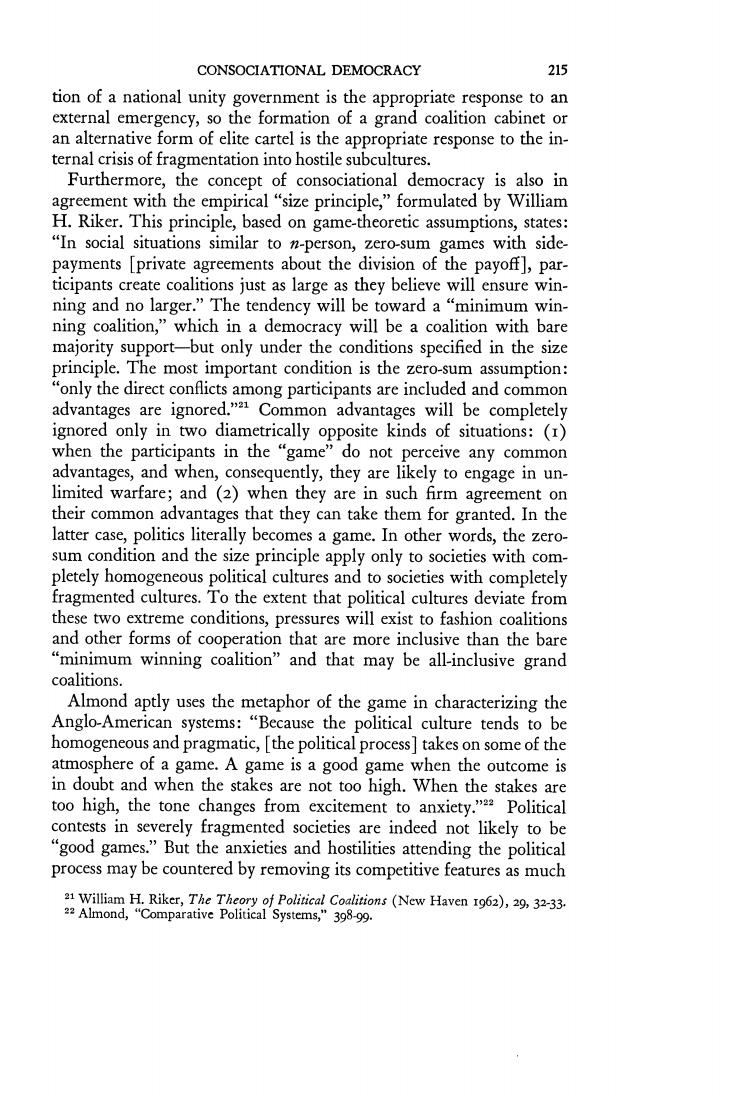
CONSOCIATIONAL DEMOCRACY 215 tion of a national unity government is the appropriate response to an external emergency,so the formation of a grand coalition cabinet or an alternative form of elite cartel is the appropriate response to the in- ternal crisis of fragmentation into hostile subcultures. Furthermore,the concept of consociational democracy is also in agreement with the empirical"size principle,"formulated by William H.Riker.This principle,based on game-theoretic assumptions,states: "In social situations similar to n-person,zero-sum games with side- payments [private agreements about the division of the payoff],par- ticipants create coalitions just as large as they believe will ensure win- ning and no larger."The tendency will be toward a "minimum win- ning coalition,"which in a democracy will be a coalition with bare majority support-but only under the conditions specified in the size principle.The most important condition is the zero-sum assumption: "only the direct conflicts among participants are included and common advantages are ignored."Common advantages will be completely ignored only in two diametrically opposite kinds of situations:(I) when the participants in the "game"do not perceive any common advantages,and when,consequently,they are likely to engage in un- limited warfare;and (2)when they are in such firm agreement on their common advantages that they can take them for granted.In the latter case,politics literally becomes a game.In other words,the zero- sum condition and the size principle apply only to societies with com- pletely homogeneous political cultures and to societies with completely fragmented cultures.To the extent that political cultures deviate from these two extreme conditions,pressures will exist to fashion coalitions and other forms of cooperation that are more inclusive than the bare "minimum winning coalition"and that may be all-inclusive grand coalitions. Almond aptly uses the metaphor of the game in characterizing the Anglo-American systems:"Because the political culture tends to be homogeneous and pragmatic,[the political process]takes on some of the atmosphere of a game.A game is a good game when the outcome is in doubt and when the stakes are not too high.When the stakes are too high,the tone changes from excitement to anxiety."Political contests in severely fragmented societies are indeed not likely to be "good games."But the anxieties and hostilities attending the political process may be countered by removing its competitive features as much 21 William H.Riker,The Theory of Political Coalitions(New Haven 1962),29,32-33. 22 Almond,"Comparative Political Systems,"398-99

216 WORLD POLITICS as possible.In consociational democracies,politics is treated not as a game but as a serious business. FACTORS CONDUCIVE TO CONSOCIATIONAL DEMOCRACY Consociational democracy means government by elite cartel designed to turn a democracy with a fragmented political culture into a stable democracy.Efforts at consociationalism are not necessarily successful, of course:consociational designs failed in Cyprus and Nigeria,and Uruguay abandoned its Swiss-style consociational system.Successful consociational democracy requires:(I)That the elites have the ability to accommodate the divergent interests and demands of the subcul- tures.(2)This requires that they have the ability to transcend cleav- ages and to join in a common effort with the elites of rival subcultures. (3)This in turn depends on their commitment to the maintenance of the system and to the improvement of its cohesion and stability.(4) Finally,all of the above requirements are based on the assumption that the elites understand the perils of political fragmentation.These four requirements are logically implied by the concept of consocia- tional democracy as defined in this paper.Under what conditions are they likely to be fulfilled?An examination of the successful consocia- tional democracies in the Low Countries,Switzerland,Austria,and Lebanon suggests a number of conditions favorable to the establish- ment and the persistence of this type of democracy.These have to do with inter-subcultural relations at the elite level,inter-subcultural rela- tions at the mass level,and elite-mass relations within each of the subcultures. RELATIONS AMONG THE ELITES OF THE SUBCULTURES It is easier to assess the probability of continued success of an already established consociational democracy than to predict the chance of success that a fragmented system would have if it were to attempt consociationalism.In an existing consociational democracy,an investi- gation of the institutional arrangements and the operational code of inter-elite accommodation can throw light on the question of how thorough a commitment to cooperation they represent and how effec- tive they have been in solving the problems caused by fragmentation. The length of time a consociational democracy has been in operation is also a factor of importance.As inter-elite cooperation becomes habit- ual and does not represent a deliberate departure from competitive responses to political challenges,consociational norms become more